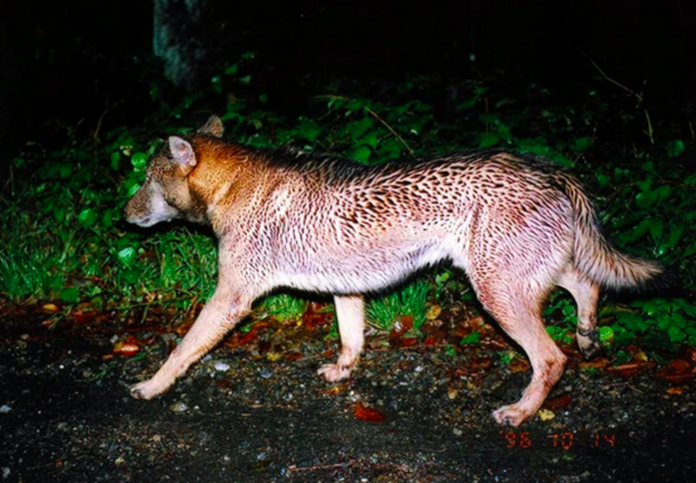Japanese wolf perhaps not extinct, but proof remains elusive
OMACHI, Nagano Prefecture–The Japanese wolf, a species thought to have gone extinct more than a century ago, may still roam the rugged mountain terrain of central Japan–but finding solid proof remains elusive despite a string of “sightings.”
Hiroshi Yagi, who heads a nonprofit organization dedicated to proving Japanese wolves still exist, believes he will one day be able to prove his hunch.
While giving address about his work in mid-November at the famed Omachi Alpine Museum here, multiple participants came forward with stories of having come across creatures they believed to be Japanese wolves.
The event was held to coincide with a special exhibition about the city and the animals that used to inhabit the area.
The last known sighting of a Japanese wolf, one kept in captivity in Nara Prefecture, was in 1905.
The exhibition featuring stuffed specimens of a Japanese crested ibis and a river otter, as well as the skull of a Japanese wolf, will wind up on Jan. 28. The alpine museum is the only one of its kind in Japan.
During Yagi’s speech, multiple participants reported sightings of “animals that appeared to be Japanese wolves.”
SKULL SHIPPED OUT BY SIEBOLD
Japanese wolves were last officially recorded in Nagano Prefecture during the Meiji Era (1868-1912). Despite that, there have been a string of supposed sightings in recent years and claims of having heard the animals howling in the wilderness.
Yagi, 74, reckons he heard a wolf howling in July 1969 when he stayed at a mountain hut as a staff member on Mount Naebasan near the border between Nagano and Niigata prefectures. He has since devoted much time to tracking down a live specimen.
Only three specimens of Japanese wolf exist at the National Museum of Nature and Science in Tokyo and elsewhere in Japan. There are no known photos of live wolves.
The only type specimen that could identify the Japanese wolf is kept at a Dutch museum. It was shipped to the Netherlands by German doctor Philipp Franz von Siebold, who arrived in Japan during the late Edo Period (1603-1867).
Siebold sent the fur and skull of a Japanese wolf, as well as a “yamainu” (mountain dog).
The type specimen’s stand refers to the sample as that of a yamainu to raise a question: Is the Japanese wolf the same as yamainu? Confusion lingers over whether the two animals are one and the same or different from each other.
What is clear is that Japanese wolves were killed off before Japanese researchers took an interest in them. As a result, little is known about the species.
During the recent session, Yagi presented the findings of his years-long research into Japanese wolves.
An image of a canine seen in a mountain area of the Chichibu region in Saitama Prefecture, outside Tokyo, in October 1996 proved to be of particular interest.
Spotting a mammal about the size of a Kishu dog, Yagi thought it “must be a Japanese wolf” and sent a photograph of the animal to the former head of the National Museum of Nature and Science’s Department of Zoology.
“It is at least certain that the animal is valuable, given the possibility of it being a surviving Japanese wolf,” the ex-department chief said in the reply to Yagi, citing 12 features, such as ear shape, shorter forelegs and blackish tail tip.
Yagi named the newly uncovered creature “Chichibu wild dog.” He believes it provides evidence for the Japanese wolf’s presence.
SUCCESSIVE SIGHTINGS
Toward the end of the gathering, a member of the audience shared a surprising tidbit.
Kazuyuki Tsutsui, 57, a resident of Nagano city’s Shinshu-Shinmachi district, said he spotted a large hound while slowing on a curve as he drove home one night five or six years ago.
“I love animals in the wild so much that I can distinguish almost all of them, but this one fell outside the scope of my expertise,” Tsutsui said. “But when I saw the Chichibu wild dog in a TV show, I thought ‘that’s it.’”
Hiroyuki Ito, 53, who came from Tokyo’s Akishima district, said he encountered a peculiar hound-like animal 10 years earlier at the Tokusa Pass in Yamanashi Prefecture, while he was snapping photographs of the starry sky.
“It emerged at a distance of just 15 meters around 5 a.m.,” Ito recalled. “It was muscular and had smaller ears and a straight tail. The Chichibu wild dog in the image really resembles the one I came across.”
Ito also explained that he heard howls like those experienced by Yagi in the Otome and Mikubo highlands of Yamanashi Prefecture on many occasions.
Yagi has renewed hope his own quest will not be in vain.
“You must record that howling,” Yagi told Ito. “Analyzing your data can help decide what kind of animal it is. Examining more than one case will help us get closer to the truth.”

